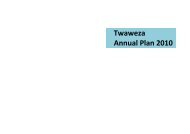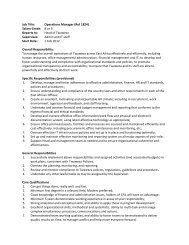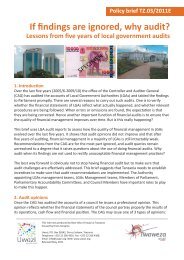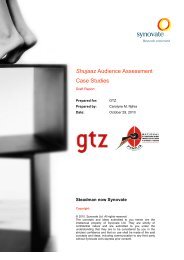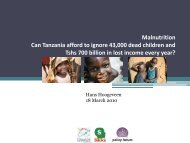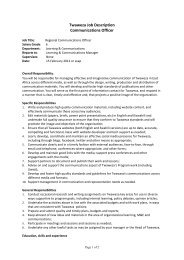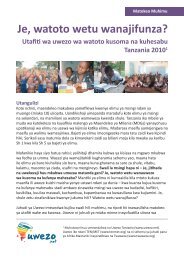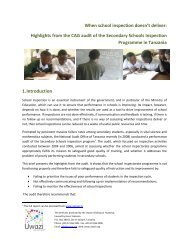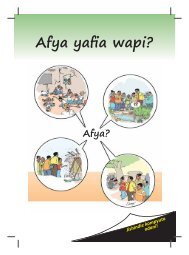Primary schools in Dar es Salaam Overcrowded and without sufficient text books
Primary schools in Dar es Salaam: Overcrowded and ... - Uwazi.org
Primary schools in Dar es Salaam: Overcrowded and ... - Uwazi.org
- No tags were found...
You also want an ePaper? Increase the reach of your titles
YUMPU automatically turns print PDFs into web optimized ePapers that Google loves.
Uwazi monitor<strong>in</strong>g Brief no. 3 May 2011<br />
<strong>Primary</strong> <strong>schools</strong> <strong>in</strong> <strong>Dar</strong> <strong>es</strong> <strong>Salaam</strong>:<br />
<strong>Overcrowded</strong> <strong>and</strong> <strong>without</strong> <strong>sufficient</strong> <strong>text</strong> <strong>books</strong><br />
Key f<strong>in</strong>d<strong>in</strong>gs<br />
• With an average class size of 81, classrooms <strong>in</strong> many <strong>schools</strong> are overcrowded<br />
• 45 percent of surveyed <strong>schools</strong> do not have enough d<strong>es</strong>ks <strong>and</strong> many pupils sit on the<br />
floor<br />
• Availability of <strong>text</strong> <strong>books</strong> is a key challenge<br />
“Although Tanzania was recently awarded a prize by the United Nations for excell<strong>in</strong>g <strong>in</strong> enroll<strong>in</strong>g primary school<br />
pupils, the quality of education the country offers is pathetic.”—The Citizen, 19 October 2010.<br />
Introduction<br />
S<strong>in</strong>ce 2002, the Government of Tanzania has been implement<strong>in</strong>g the <strong>Primary</strong> Education<br />
Development Programme (PEDP) with two specific aims: mak<strong>in</strong>g education more acc<strong>es</strong>sible<br />
<strong>and</strong> improv<strong>in</strong>g its quality. While significant succ<strong>es</strong>s has been made <strong>in</strong> extend<strong>in</strong>g acc<strong>es</strong>s,<br />
improv<strong>in</strong>g quality rema<strong>in</strong>s a challenge.<br />
<strong>Dar</strong> <strong>es</strong> <strong>Salaam</strong> is the larg<strong>es</strong>t city <strong>in</strong> the country <strong>and</strong> the one clos<strong>es</strong>t to where polici<strong>es</strong> are<br />
made, so it is often assumed that the situation there is generally better than elsewhere.<br />
Still, the media has published anecdotal evidence about <strong>schools</strong> <strong>in</strong> <strong>Dar</strong> <strong>es</strong> <strong>Salaam</strong> lack<strong>in</strong>g<br />
learn<strong>in</strong>g materials <strong>and</strong> be<strong>in</strong>g <strong>in</strong> dire need of improvement. Aga<strong>in</strong>st this backdrop, Uwazi<br />
carried out a survey between August <strong>and</strong> December 2010 to ass<strong>es</strong>s the quality of ameniti<strong>es</strong><br />
<strong>in</strong> a sample of 40 primary <strong>schools</strong> <strong>in</strong> <strong>Dar</strong> <strong>es</strong> <strong>Salaam</strong>’s three districts: Ilala, K<strong>in</strong>ondoni, <strong>and</strong><br />
Temeke.<br />
The data gathered show that, contrary to common belief, public <strong>schools</strong> <strong>in</strong> <strong>Dar</strong> <strong>es</strong> <strong>Salaam</strong><br />
face major challeng<strong>es</strong> <strong>in</strong> provid<strong>in</strong>g faciliti<strong>es</strong> of adequate quality for pupils. Poor quality<br />
<strong>and</strong> quantity of classrooms, an <strong>in</strong><strong>sufficient</strong> number of d<strong>es</strong>ks, <strong>and</strong> a lack of <strong>text</strong> <strong>books</strong> are<br />
all common occurrenc<strong>es</strong>. Uwazi believ<strong>es</strong> that most of th<strong>es</strong>e challeng<strong>es</strong> can be r<strong>es</strong>olved,<br />
but do<strong>in</strong>g so will require first <strong>and</strong> foremost an <strong>in</strong>formed public that has acc<strong>es</strong>s to space to<br />
mean<strong>in</strong>gfully engage <strong>and</strong> contribute to discussions to improve quality <strong>in</strong> <strong>schools</strong>.<br />
F<strong>in</strong>d<strong>in</strong>g 1: Classrooms are overcrowded <strong>and</strong> not conducive to learn<strong>in</strong>g<br />
The average number of pupils per classroom <strong>in</strong> the surveyed <strong>schools</strong> is 81, much higher<br />
than the national target of 40 pupils per classroom that was to have been reached <strong>in</strong><br />
This brief was produced under the general guidance of Rose<br />
Aiko of Uwazi at Twaweza, housed by Hivos-Tanzania.<br />
Uwazi, P.O. Box 38342, <strong>Dar</strong> <strong>es</strong> <strong>Salaam</strong>, Tanzania.<br />
Telephone +255 22 266 4301. Fax +255 22 266 4308.<br />
Email: <strong>in</strong>fo@uwazi.org. Web: www.uwazi.org<br />
Released May, 2011.<br />
1
2010. Considerable variation exists between <strong>schools</strong> (see Figure 1). At Buguruni Viziwi,<br />
Gerezani, Uhuru Wasichana, <strong>and</strong> Muhimbili primary <strong>schools</strong>, the class size rang<strong>es</strong> from<br />
13 to 45, mak<strong>in</strong>g student-teacher <strong>in</strong>teractions at least feasible. Buguruni Viziwi, a special<br />
school for the deaf, outperforms all others <strong>in</strong> terms of class size, with a pupil to classroom<br />
ratio of 10:1. In addition to a low class size, which is required to meet the special needs<br />
of pupils, the school also has other ameniti<strong>es</strong> that are of better quality compared to most<br />
of other <strong>schools</strong> visited, thanks to f<strong>in</strong>ancial support from well wishers. Other <strong>schools</strong> such<br />
as Mbagala, Vijibweni, <strong>and</strong> T<strong>and</strong>ika (<strong>in</strong> Temeke district) <strong>and</strong> Bunju A <strong>and</strong> Kunduchi (<strong>in</strong><br />
K<strong>in</strong>ondoni district) are, however, on the other end of the spectrum, with more than 130<br />
pupils per classroom. Vijibweni, T<strong>and</strong>ika, <strong>and</strong> Bunju A attempt to cope with this situation by<br />
teach<strong>in</strong>g St<strong>and</strong>ard 1 <strong>and</strong> 2 pupils <strong>in</strong> shifts or on a rotation basis.<br />
Figure 1: Pupil to classroom ratio <strong>in</strong> the <strong>schools</strong> surveyed<br />
Not all classrooms <strong>in</strong> <strong>schools</strong> with a<br />
good pupil to classroom ratio are healthy<br />
environments for learn<strong>in</strong>g. For example,<br />
d<strong>es</strong>pite hav<strong>in</strong>g an average class size of<br />
41 pupils, close to the government’s<br />
recommended st<strong>and</strong>ard, Amana <strong>Primary</strong><br />
School <strong>in</strong> Ilala district is a ‘dy<strong>in</strong>g’ school.<br />
Established <strong>in</strong> 1947, the school looks as if no<br />
repairs have been done s<strong>in</strong>ce it was built: its<br />
2<br />
Source of data: Uwazi, 2010.<br />
“At tim<strong>es</strong> there will be loud music com<strong>in</strong>g<br />
from neighbour<strong>in</strong>g bus<strong>in</strong><strong>es</strong>s <strong>and</strong> r<strong>es</strong>idential<br />
build<strong>in</strong>gs which disturb learn<strong>in</strong>g,” says the<br />
head teacher of Amana <strong>Primary</strong> School. “If the<br />
Government still wants to ma<strong>in</strong>ta<strong>in</strong> this place<br />
as a school, major repairs are needed or (even)<br />
construction of (new) storey build<strong>in</strong>gs, after<br />
pull<strong>in</strong>g down the exist<strong>in</strong>g on<strong>es</strong>.”<br />
walls are mouldy, with pa<strong>in</strong>t peel<strong>in</strong>g off, <strong>and</strong> its w<strong>in</strong>dows <strong>and</strong> ceil<strong>in</strong>g are <strong>in</strong> total disrepair.<br />
Situated <strong>in</strong> a cramped area <strong>in</strong> the middle of Ilala, it is hard for a visitor to even recognize<br />
that a school exists here. Its low population (288 pupils) reflects the lack of <strong>in</strong>ter<strong>es</strong>t <strong>in</strong> the<br />
school shown by r<strong>es</strong>idents <strong>in</strong> the neighbourhood; most parents opt to take their children<br />
elsewhere s<strong>in</strong>ce the environment at Amana do<strong>es</strong> not seem favourable for learn<strong>in</strong>g.<br />
F<strong>in</strong>d<strong>in</strong>g 2: In half of the <strong>schools</strong>, pupils must sit on the floor<br />
On average, five pupils share one d<strong>es</strong>k <strong>in</strong> the surveyed <strong>schools</strong>, with considerable variation<br />
across <strong>schools</strong>. In almost half of the <strong>schools</strong> (18 out of 40) there are not enough d<strong>es</strong>ks to<br />
cater to all pupils <strong>and</strong> many children sit on the floor (see Figure 2). Generally, <strong>schools</strong> that<br />
have a high pupil to classroom ratio are also the on<strong>es</strong> that lack <strong>sufficient</strong> d<strong>es</strong>ks.
Figure 2: Are pupils sitt<strong>in</strong>g on the floor?<br />
Source of data: Uwazi, 2010.<br />
At Kunduchi <strong>Primary</strong> School, lack of d<strong>es</strong>ks is a major problem. About three quarters of<br />
the school’s 1,931 pupils do not have d<strong>es</strong>ks to sit at, clearly underm<strong>in</strong><strong>in</strong>g the quality of<br />
education the school offers. Without r<strong>es</strong>ourc<strong>es</strong> from the Government to assist <strong>schools</strong> like<br />
this, the only hope is that other stakeholders become aware of the situation <strong>and</strong> contribute<br />
with donations.<br />
F<strong>in</strong>d<strong>in</strong>g 3: Availability of <strong>text</strong> <strong>books</strong> is a major challenge<br />
Availability of <strong>text</strong> <strong>books</strong> is critical to learn<strong>in</strong>g. However, the survey shows that <strong>in</strong> most<br />
<strong>schools</strong>, <strong>text</strong> <strong>books</strong> are lack<strong>in</strong>g. The average pupil to <strong>text</strong> book ratio is 5 to 1 <strong>in</strong> lower<br />
primary school class<strong>es</strong> <strong>and</strong> 6 to 1 <strong>in</strong> upper primary school class<strong>es</strong> (see Figure 3).<br />
Figure 3: Average pupil to <strong>text</strong> book ratio <strong>in</strong> <strong>Dar</strong> <strong>es</strong> <strong>Salaam</strong> <strong>schools</strong> surveyed<br />
Source of data: Uwazi, 2010.<br />
Across <strong>schools</strong>, there is major variation <strong>in</strong> the availability of <strong>books</strong>. At 2:1, the pupil to <strong>text</strong><br />
book ratio at Mlimani <strong>Primary</strong> School is one of the b<strong>es</strong>t among the surveyed <strong>schools</strong>. This<br />
relatively better situation is because most pupils <strong>in</strong> the school br<strong>in</strong>g <strong>books</strong> purchased for<br />
them by their parents, <strong>and</strong> not because the school is better funded. At Kunduchi <strong>Primary</strong><br />
School, the pupil:book ratio for the whole school <strong>and</strong> across all subjects is 10:1; at T<strong>and</strong>ika’s<br />
3
Upper <strong>Primary</strong> School, it is 15:1. At Bunju A, for some subjects the pupil:book ratio is as<br />
high as 45:1. At the extreme, the head teacher at Mbagala <strong>Primary</strong> School reports that <strong>in</strong><br />
its upper primary <strong>schools</strong>, only teachers have <strong>text</strong> <strong>books</strong>. As <strong>in</strong> Mlimani, some <strong>schools</strong> are<br />
now tak<strong>in</strong>g matters <strong>in</strong>to their own h<strong>and</strong>s. For example, accord<strong>in</strong>g to the head teacher at<br />
Kunduchi, the school has requ<strong>es</strong>ted parents of pupils <strong>in</strong> grad<strong>es</strong> 4 <strong>and</strong> 7 to buy <strong>books</strong> for<br />
their children.<br />
Conclusion<br />
Almost a decade after the start of PEDP, the provision of <strong>sufficient</strong> school ameniti<strong>es</strong> such as<br />
class rooms, d<strong>es</strong>ks, <strong>and</strong> <strong>text</strong> <strong>books</strong> rema<strong>in</strong>s a challenge, even <strong>in</strong> <strong>Dar</strong> <strong>es</strong> <strong>Salaam</strong>. Accord<strong>in</strong>g to<br />
the Basic Education Statistics published by the M<strong>in</strong>istry of Education, primary <strong>schools</strong> <strong>in</strong> <strong>Dar</strong><br />
<strong>es</strong> <strong>Salaam</strong> are better endowed than many others <strong>in</strong> the country. For <strong>in</strong>stance, <strong>in</strong> Temeke<br />
district, the pupil:teacher ratio <strong>in</strong> 2009 was reported as 46:1, while the national average<br />
was 55:1. In contrast, the average for Geita district <strong>in</strong> Mwanza which is very far from <strong>Dar</strong><br />
<strong>es</strong> <strong>Salaam</strong>, was 78:1. If ameniti<strong>es</strong> <strong>in</strong> the better r<strong>es</strong>ourced districts still leave so much to be<br />
d<strong>es</strong>ired, as shown <strong>in</strong> this brief, then there should be significant concerns for the education<br />
of children <strong>in</strong> the l<strong>es</strong>ser funded districts.<br />
Annex: Public primary <strong>schools</strong> visited <strong>in</strong> the survey<br />
Temeke District (16) Ilala District (13) K<strong>in</strong>ondoni District (11)<br />
Vijibweni Buguruni Moto Mpya Kawe A<br />
Mji Mwema Boma Kumbukumbu<br />
Miv<strong>in</strong>jeni Amana Mapambano<br />
Toa Ngoma Buguruni Viziwi Mbuyuni<br />
Kibada Msimbazi Mseto Oysterbay<br />
Chang’ombe Gerezani K<strong>in</strong>ondoni<br />
Geza Ulole Muhimbili Msisiri<br />
Mtoni Kijichi Ukonga Mlimani<br />
Kimbiji Buguruni Moto Bunju A<br />
Kuras<strong>in</strong>i Buguruni Mtongani<br />
Kibugumo Mnazi Mmoja Kunduchi<br />
T<strong>and</strong>ika<br />
Uhuru Wasichana<br />
Mgulani<br />
Mikwambe<br />
Kigamboni<br />
Mbagala<br />
Bunge<br />
Source of data<br />
This brief is part of ongo<strong>in</strong>g citizen monitor<strong>in</strong>g at Uwazi, www.uwazi.org. The data<br />
were collected through a monitor<strong>in</strong>g survey conducted by Uwazi between August <strong>and</strong><br />
December 2010. All data can be obta<strong>in</strong>ed from Uwazi.<br />
4




